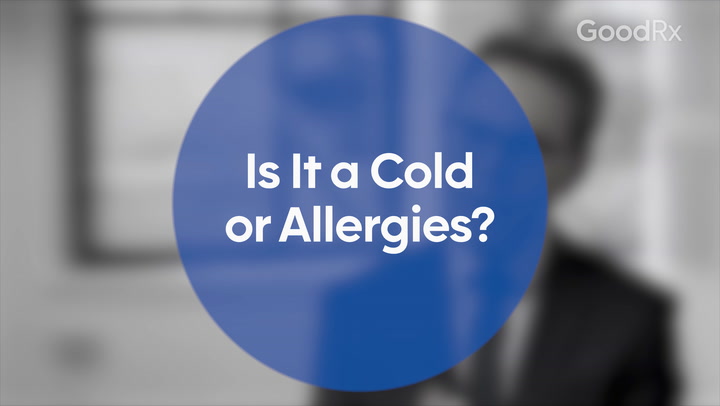
Common Cold Treatments: There’s No Cure, But Here’s How to Ease Your Symptoms
Key takeaways:
More than 200 different viruses cause colds, so it can be tricky to find a common cold treatment.
Treatment for the common cold focuses on helping people feel better as fast as possible. Over-the-counter (OTC) decongestants and pain relievers can ease symptoms.
There’s no cure for the common cold, and there probably won’t be one anytime soon. But handwashing and keeping distance from people with cold symptoms can prevent you from getting sick.
Access savings on related medications
Table of contents

Is it really winter if you haven’t caught a cold? There are at least 200 different viruses that can cause upper respiratory tract infections, including the common cold. So it’s no wonder that people often wake up with the telltale signs of a cold.
Maybe you’ve heard from a healthcare professional or a knowledgeable family member that there’s no cure for the common cold. Unfortunately, they’re right.
But considering how common colds are, how’s it possible that we don’t have a cure yet? Cold viruses may cause similar symptoms. However, the viruses are different enough from each other that it’s unlikely any single common cold treatment will ever be able to cure them all. The best you can do is manage the symptoms while your immune system fights off the infection.
Search and compare options
Here are five common cold treatments — plus at-home remedies — that can help you manage your symptoms.
1. Decongestants
Decongestants are a type of medication that relieves nasal and sinus congestion. They’re available over the counter (OTC) and sometimes combined with other common cold treatments, like antihistamines and expectorants. Keep in mind that kids under the age of 4 shouldn’t take cold and flu medications.
Decongestants are available as pills that you take by mouth, such as pseudoephedrine (Sudafed), and as nasal sprays.
Nasal sprays offer instant relief, but they can only be used for 2 to 3 days. Using nasal decongestants for too long can lead to rebound congestion, a complication that’s difficult to treat. Be sure to keep this in mind when using popular nasal decongestants such as:
Phenylephrine (Afrin, Neo-Synephrine, 4-Way Fast Acting, Children’s Afrin)
Oxymetazoline (12 Hour Decongestant, Afrin, Dristan, Mucinex, Vicks Decongestant)
Good to know: In 2023, the FDA announced that oral phenylephrine (Sudafed PE) was no longer considered an effective treatment for nasal congestion. But the FDA still considers phenylephrine nasal sprays as effective alternatives.
2. Pain relievers
OTC pain relievers can ease sore throat, aching muscles, and headache, as well as fever. You can try pain relievers like acetaminophen (Tylenol) and ibuprofen (Advil, Motrin) to help relieve these common cold symptoms.
Just keep in mind that these pain relievers are often added to OTC cold medications. Always check the active ingredient list on your medications to avoid accidentally taking too much acetaminophen or ibuprofen.
Stages of a cold: Learn how long a cold lasts and what to expect as you recover.
Foods for a cold: You may not have much of an appetite when you aren’t feeling well, but your body still needs nutrition. Here are some tips on what to eat with a cold.
How to prevent a cold: Colds are quite common, but there are steps you can take to help prevent getting a cold in the first place.
3. Nasal sprays
Aside from nasal decongestants, there are other types of nasal sprays that can help lessen cold symptoms:
Cromolyn sodium: OTC cromolyn sodium (NasalCrom) nasal spray can help lessen symptoms like sore throat, cough, and congestion.
Saline spray: Saline nasal spray is a go-to for common colds. Saline spray can moisten irritated nasal passages and clear out mucus.
Ipratropium bromide: Ipratropium bromide nasal sprays may help ease congestion and runny nose. But these nasal sprays require a prescription.
4. Guaifenesin
Guaifenesin works by loosening mucus so it’s easier to cough up. It’s available OTC in pill and syrup forms. Guaifenesin is usually combined with other cold medications. So make sure to check the active ingredient lists so you don’t accidentally double up on guaifenesin doses.
5. Zinc
Some studies show that zinc lozenges may help relieve cold symptoms and help people recover from cold symptoms faster. Zinc appears to be more likely to help if you start taking it as soon as you begin to feel sick (within 24 hours).
But not all studies have come to the same conclusion about how effective zinc is for cold symptoms. And high doses of zinc can lead to side effects like nausea, stomach upset, and changes in taste.
So approach this remedy with caution, especially if you’re considering zinc nasal sprays. Some data suggests that zinc nasal sprays may lead to permanent anosmia (loss or change in the sense of smell).
Take our quiz: OTC cold and cough medicines
At-home common cold remedies
There are many non-medication remedies that you can try at home to relieve cold symptoms. The next time you have a cold, consider trying these home remedies:
Humidifier: A humidifier can help ease congestion. It also adds moisture to the air, making it easier for your irritated nasal passages to breathe it in.
Heating pads: Heating pads can help with muscle aches.
Honey: Honey can ease cough and cough-related symptoms. You can try a teaspoon of honey or mix it into warm tea. But don’t give honey to children under 1 year of age.
Fluids: Drinking plenty of fluids helps thin mucus and keeps you from getting dehydrated.
Rest: Rest and sleep give your body time to repair and focus on fighting off the virus that’s causing your cold.
There’s a lot of interest in using supplements like echinacea or vitamin C to give your immune system a cold-fighting boost. But right now, there’s no evidence that echinacea can lessen common cold symptoms for everyone.
One study showed that people who take vitamin C every day may develop fewer colds. But that same study showed that taking vitamin C once you’ve developed a cold won’t make your cold go away faster.
How do you get rid of a cold fast?
There’s no way to get rid of a cold fast. Once the virus settles in, cold symptoms usually continue until your body is able to completely clear out the virus, which takes about 1 week.
The best way to support your body is to rest, drink lots of water, and eat well. By giving your body the nutrition and rest it needs, you empower it to fight off the virus effectively.
Can antibiotics treat a cold?
No, antibiotics can’t treat or cure a common cold. Antibiotics treat infections caused by bacteria — not viruses. That’s why antibiotics won’t help you feel better if you have a cold.
But you can have a cold and then develop a bacterial infection on top of the cold. This is a superimposed bacterial infection. Viruses can change the number of healthy bacteria in the respiratory tract, which makes it easier for you to catch a bacterial infection. If you have a superimposed bacterial infection, like pneumonia or a sinus infection, you’ll need to visit a healthcare professional to take antibiotics.
In general, it’s a good idea to avoid taking antibiotics unless you really need them. Not only will you be spared from antibiotic side effects, but you’ll also lower your risk of developing antibiotic resistance. Antibiotic resistance is a situation where antibiotics don’t work against bacteria as well as they should, which puts you at risk for serious infections.
How long does a common cold last?
Common cold symptoms typically last about 7 to 10 days, and cold stages are fairly predictable. But symptoms can last longer if you smoke or have a weak immune system or another upper respiratory tract infection along with your cold (like the flu).
Most people start to develop symptoms within 1 to 3 days after being exposed to a cold virus. Common cold symptoms peak at 1 to 3 days and last for about 7 to 10 days. But mild symptoms, like nasal congestion, runny nose, and cough, can take up to 3 weeks to completely go away.
When to see a doctor
Most of the time you’ll be able to manage a cold at home. But there are things to watch for. Here’s when to get medical attention for a cold:
Your symptoms aren’t improving in 10 days, or they seem to get better and then get worse.
Your symptoms are severe. For example, you have a fever that lasts longer than 4 days, dehydration, difficulty breathing, or symptoms that go away and come back or get worse.
A child younger than 2 months old has a fever or is lethargic.
How can you prevent the common cold?
No one wants to deal with cold symptoms, so your best bet is to try to avoid catching a cold altogether. This might feel impossible, especially if you have kids who’re exposed to a lot of germs at school. But there are some simple — and important — preventive measures you can take:
Wash your hands with soap and water often to avoid introducing a cold virus into your body.
Try to avoid touching your eyes, nose, or mouth, especially if you can’t wash your hands.
Avoid people who’re sick and can pass cold germs to you.
Avoid spending time in crowded, tight spaces with poor ventilation.
Avoid activities that weaken your immune system, like drinking lots of alcohol, eating poorly, and not getting enough sleep.
Eat a diet that includes important nutrients like vitamin C.
Get regular physical activity.
Frequently asked questions
Blowing your nose won’t cure your cold, but it may help relieve some of your symptoms. Having a stuffy nose can make it hard to breathe, so clearing it can help remove mucus. But avoid blowing too forcefully, as this can lead to damage, such as nosebleeds and even eardrum rupture.
Cold symptoms tend to be at their worst 1 to 3 days from when your symptoms first begin. This is also when you’re most contagious. By about day 10, you should be past the worst of your cold symptoms. But remember that some symptoms may linger up to 3 weeks.
No, sweating won’t get rid of your cold. But, depending on how severe your cold is, you can likely do mild-to-moderate exercise if you’re up for it. Listen to your body and make sure to stay hydrated and not overdo it.
The bottom line
The common cold is called “common” for a reason — there are dozens of viruses going around your community at any given time that can make you sick with a cold. The good news is that you can take steps to keep your immune system healthy and avoid catching a cold.
If you do get sick, common cold treatments can help you manage your symptoms and feel better. But, unfortunately, there’s still no cure for the common cold.
Why trust our experts?



References
Aberg, N., et al. (1996). The effect of inhaled and intranasal sodium cromoglycate on symptoms of upper respiratory tract infections. Clinical and Experimental Allergy: Journal of the British Society for Allergy and Clinical Immunology.
Abuelgasim, H., et al. (2021). Effectiveness of honey for symptomatic relief in upper respiratory tract infections: A systematic review and meta-analysis. BMJ Evidence-Based Medicine.
Allan, G. M., et al. (2014). Prevention and treatment of the common cold: Making sense of the evidence. Canadian Medical Association Journal.
Davidson, T. M., et al. (2010). The Bradford Hill criteria and zinc-induced anosmia: A causality analysis. Archives of Otolaryngology--Head & Neck Surgery.
D’Cruze, H., et al. (2009). Is intranasal zinc effective and safe for the common cold? A systematic review and meta-analysis. Database of Abstracts of Reviews of Effects (DARE): Quality-assessed Reviews.
Hanada, S., et al. (2018). Respiratory viral infection-induced microbiome alterations and secondary bacterial pneumonia. Frontiers in Immunology.
Healthy Children. (2021). Fever and your baby.
Hemilä, H. (2013). Vitamin C for preventing and treating the common cold. The Cochrane Database of Systematic Reviews.
Hemilä, H. (2011). Zinc lozenges may shorten the duration of colds: A systematic review. The Open Respiratory Medicine Journal.
Hunter, J., et al. (2021). Zinc for the prevention or treatment of acute viral respiratory tract infections in adults: A rapid systematic review and meta-analysis of randomized controlled trials. The BMJ.
Karsch-Völk, M., et al. (2014). Echinacea for preventing and treating the common cold. The Cochrane Database of Systematic Reviews.
Lee, H. K., et al. (2014). The effect of exercise on prevention of the common cold: A meta-analysis of randomized controlled trial studies. Korean Journal of Family Medicine.
Ohar, J. A., et al. (2019). The role of guaifenesin in the management of chronic mucus hypersecretion associated with stable chronic bronchitis: A comprehensive review. Chronic Obstructive Pulmonary Diseases.
National Institutes for Health. (2022). Zinc: Fact sheet for health professionals
Piromchai, P., et al. (2021). Comparison of nasal patency after nose-blowing between pinch versus no pinch method: A randomized controlled trial. Scientific Reports.
Thomas, M., et al. (2023). Upper respiratory tract infection. StatPearls.
U.S. Food and Drug Administration. (2024). Should you give kids medicine for coughs and colds?
Wein, H. (2009). Understanding a common cold virus. National Institutes of Health.

























